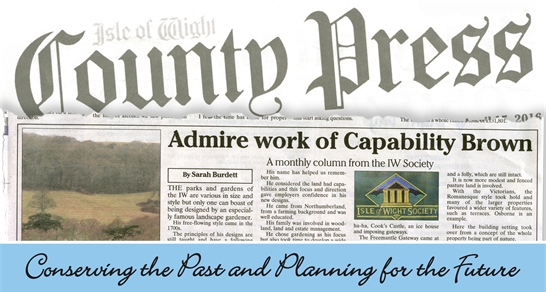Admire work of Capability Brown
The parks and gardens of the Isle of Wight are various in size and style but only one can boast of being designed by an especially famous landscape gardener. His free flowing style came in the 1700s. The principles of his designs are still taught and have a following among gardeners today here and abroad. The park on the Island is now under the patronage of English Heritage and so it is expected it will conserved and protected from development. This is Appledurcombe House where the building is now a shell but the parkland and gardens continue to flourish.
This famous person was Lancelot “Capability” Brown. He was baptised in August 1716 and this anniversary is being celebrated nationally. The Isle of Wight Garden's Trust is spearheading events here.
His name has helped us remember him. He considered that the land had capabilities and this focus and direction gave employers confidence in his new designs. He came from Northumberland from a farming background and was well educated His family was involved in woodland, land and estate management. He chose gardening as his focus but also took time to develop a wide range of related skills which included architecture. He was a competent horseman as he found this was the best way to travel. Portrails of him display a likeable face with a lively look in the eyes. The luck element in his rise to fame came from the generous patronage of Lord Cobham at Stowe in Buckinghamshire.
Appledurcome House is one of many of his gardening achievements. It is fairly intact in size and scope but the orchard area now accommodates a holiday park. It included features of Tudor and Jacobean innovation including the Ha-ha, Cook's Castle an ice house and imposing gateways. The Freemantle Gateway came at this time. His style came as a counterbalance to the French and Dutch formality of gardens close to a house and when this style returned Capability's natural look fell out of favour. However, Appledurcombe was praised, in the late 1700s, as being “picturesque” where the contrived parkland merged into the wider landscape.
Landscape parkland was a new idea in the 18th century and lasted about 200 years. Before that there can be seen at Swainston Manor elements of landscape design, with woodland walks and a folly, which are still intact. It is now more modest and fenced pasture land is involved. With the Victorians the Romanesque style took hold and many of the larger properties favoured a wider variety of features such as terraces. Osborne is an example. Here the building setting took over from a concept of the whole property being part of nature. Brown's hall marks are sweeping drives, large garden features (follies), water in lakes and rivers and clumps of trees. Features designed to endure and mature. Today the Wild Garden is in vogue and is being developed as a style that can find a niche in smaller properties as well as larger ones.
Everything changes with time. Its good to know that some things can be kept and conserved while others can be lost without problems. The anniversary of Lancelot Capability Brown is a good time to reflect, yet again, on the heritage contained in the parks and landscape of the Isle of Wight.
[Go Back]

